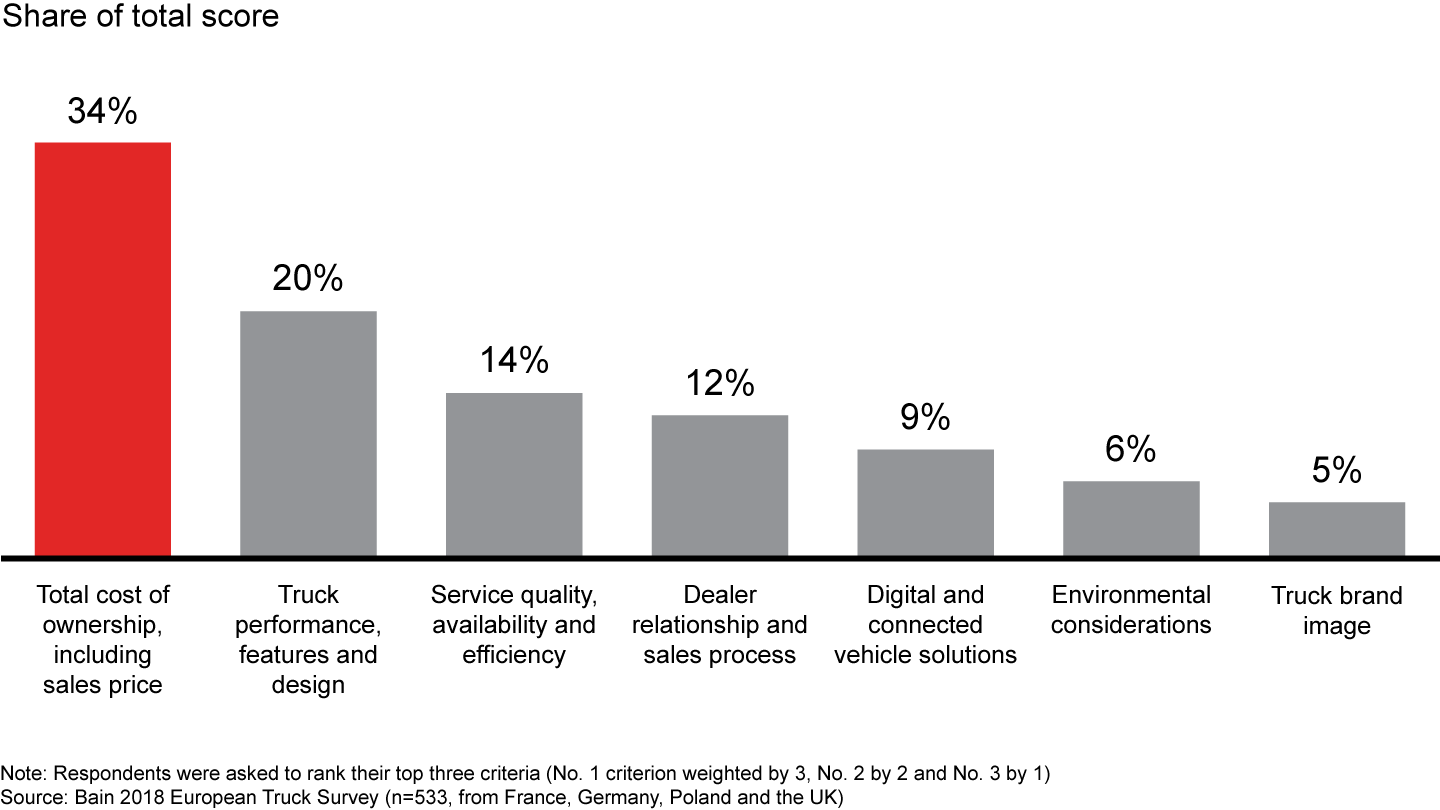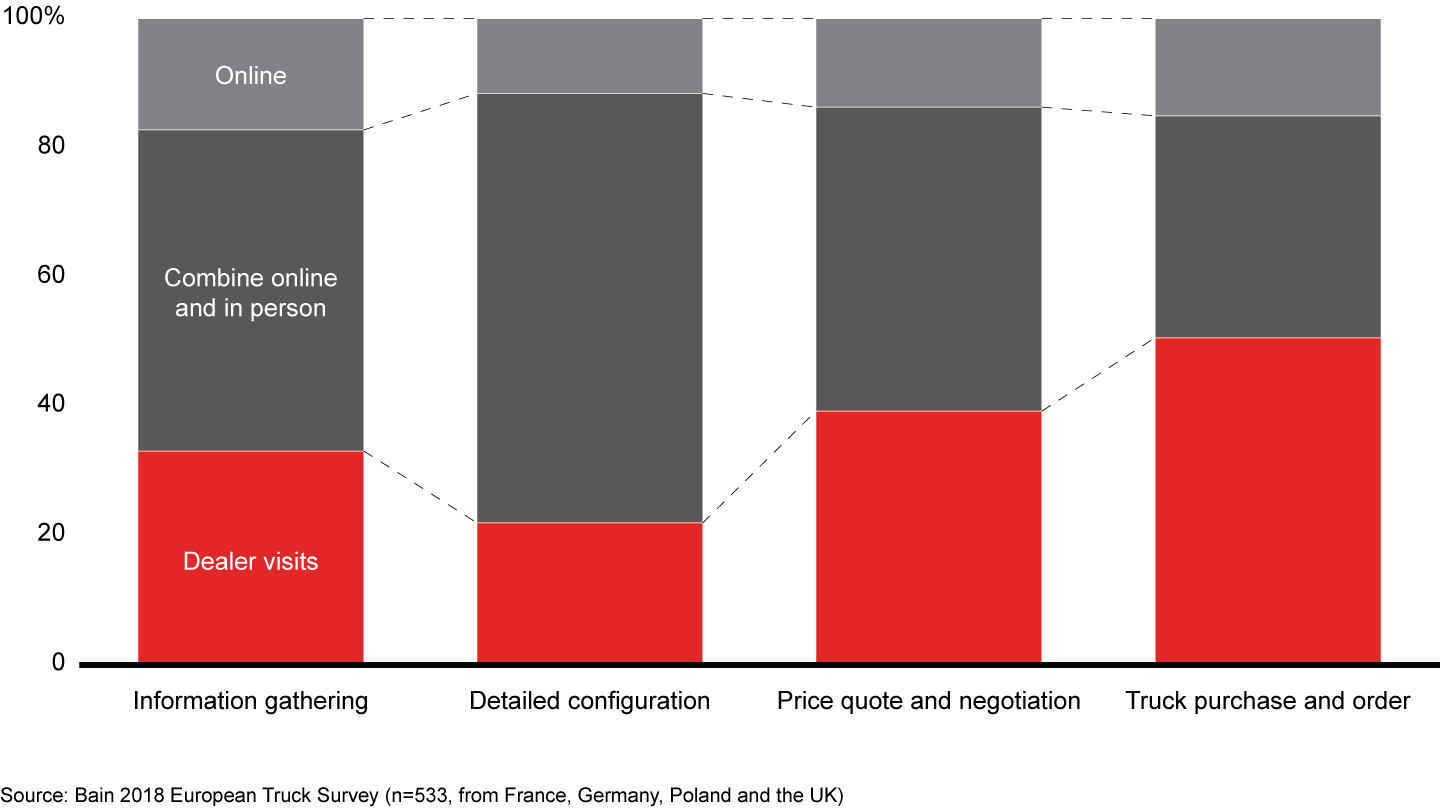Brief

In evidenza
- Truck buyers in Europe remain focused on total cost of ownership as the most important criterion in their purchase decisions.
- It is becoming increasingly difficult for Europe’s truck makers to differentiate themselves as all brands achieve a threshold of quality and TCO converges—but our study identifies ways to stand out.
- In the short term, manufacturers and dealers need to get the key touchpoints right during the sales process and help buyers make informed purchase decisions.
- In the medium and longer term, truck makers will need to meet customer demand for alternative drivetrains and respond to new business models that will force them to consider the larger ecosystem around their offerings.
While several key trends stay constant, Europe’s truck market is undergoing dramatic changes—not only in the way commercial vehicles are sold, but also in the types of vehicles customers want to buy, the future role of dealerships and the business models for ownership.
Bain & Company’s most recent survey of Europe’s truck market finds that the trend from our previous studies continues. For buyers of commercial vehicles, total cost of ownership (TCO) remains the most important factor in the purchase decision (see Figure 1). But it is becoming more challenging for truck makers to differentiate themselves in the market as hardware grows increasingly similar in the eyes of the customer. As all of the European brands approach a common threshold of quality and performance, owners are looking for other ways to measure value and choose among brands, including the sales process and alternative drivetrain offerings. For Europe’s truck makers and dealers, the key to winning lies in developing new ways to distinguish themselves.


In the short to medium term, truck makers and dealers can set themselves apart by continuing to improve TCO and getting the key touchpoints right across the sales process. For customers, purchasing a truck combines online and offline touchpoints. Buyers use multiple online and offline channels, including the dealer, as they research, configure and purchase trucks. Europe’s truck makers must find ways to integrate their digital channels with the personal sales relationship to create a seamless experience.
Even with much of the activity shifting online, the dealer remains important in the purchasing process, from specification to closure. Increasingly, the dealer’s role will be to spec the offer with optimal TCO for the customer’s specific situation. This is a growing challenge for many dealers and for truck makers’ dealer support models. Customers’ purchase behavior is becoming more sophisticated, with a surprisingly high share using their own connected fleet data for purchasing decisions. There are many touchpoints during the sales process, and truck makers’ performance at these junctures varies in quality. Truck makers must ensure that their retail development processes are well considered and robust, and that the right capabilities—often new ones that will need to be developed—are brought to bear in the network.
Also in the midterm, truck makers can differentiate themselves by delivering on customer interest in alternative drivetrains. Our survey found that interest in hybrid, electric and other alternatives is rising faster than many had anticipated. About 40% of respondents said they may want to buy hybrid or electric drivetrains in their next round of purchases. Some of this interest stems from a desire to present an eco-friendly image, as well as to gain experience with new drivetrain technology. Fleet owners say they need one or two such trucks in their fleet to improve their environmental image. Truck makers will need to find ways to satisfy this environmental pull while keeping TCO acceptable for customers.
Over the longer term, new business models enabled by emerging technologies could dramatically change the customer landscape. Interest in autonomous commercial vehicles is high, and the advent of self-driving trucks will make it more important for manufacturers to look beyond selling individual pieces of hardware. Instead, they’ll need to shift toward integrated offerings that take into consideration the new business models and how they fit into the larger ecosystems and transportation flows. Digital freight forwarders could also have a significant impact on the industry, as haulers connect to emerging platforms. Manufacturers will have to rethink their offerings and reconsider their role in that evolving value chain.
Get the touchpoints right across the sales process
Customers expect dealers to remain a key part of the purchasing process, but they expect the dealer’s role to evolve. They want dealers to help them understand the total costs of owning vehicles and guide them to the precise configurations that will deliver the most value for them. Generic information on TCO is not helpful; they want dealers to understand and support their business needs with sophisticated digital tools. For most truck makers and dealers, this will require upgrading their data analysis and systems integration capabilities so they can extract the best insights from their own and their customers’ connected systems.
Buyers combine online research with visits to dealers and test-drives to learn about vehicles and make purchase decisions. For most buyers, the dealer becomes more important as they move closer to the purchase and need help with configuration, financing, service plans and other details (see Figure 2).


Throughout the purchase process, however, many buyers rely partly or wholly on digital channels—a larger share than we expected. Manufacturers and dealers should look to create an effective and accurate purchasing process that seamlessly blends online and in-person channels. Our studies of customer loyalty, measured by the Net Promoter Score®, indicate that it’s critical to get the touchpoints right, online and in person. (For more on the Net Promoter System®, read the Bain Brief “Do Your Industrial Customers Love Their Experience?”)
More than 85% of customers said they consider two or more brands while researching a purchase. Configuration is difficult and essential to get right; customers appreciate online configurators but look to the dealer to help them navigate. Our research finds that dealers retain a high degree of influence over the configuration.
Increasingly, fleet managers and owners have access to a great deal of data on the costs and performance of their connected fleets. Half of buyers surveyed say they rely on this data in making their purchase decisions—a higher percentage than we might have expected. The fleet manager at one UK firm reviewed data on shipping loads and realized that the company needed far fewer three-axle trucks than it had been buying. Switching to two-axle vehicles reduced fuel and maintenance costs considerably.
Truck makers and dealers could use their resources to help customers understand this data and make informed decisions. Connected services are becoming more important, and customers will want them to work seamlessly in their environments. For most manufacturers, this will require an investment in boosting their own IT and analytic capabilities, so they can more easily integrate their fleet management systems with those of customers. One fleet manager told us that his company was so frustrated with the lack of interoperability with the manufacturer’s system that he was taking it into consideration in future purchase decisions.
While manufacturers improve their data analysis and integration skills, the dealer’s role will increasingly be to spec the optimal solution for the customer’s specific situation. This is a challenge for many dealers and for the manufacturers’ dealer support models—but it could become a main differentiator for those that get it right. Today, the quality of dealer networks varies. Manufacturers could do more to improve their retail development processes, including offering more integrated solutions and building the right capabilities in online networks.
Meet demand for greener trucks
One of the most surprising findings in our survey was customers’ sooner-than-expected interest in low-emission vehicles. About 40% of customers said they may want to buy one or a few electric hybrids or electric trucks in their next purchase (see Figure 3). Only 30% believe regular diesel will be the main drivetrain in their fleet by 2025.


These results may take some manufacturers by surprise: By and large, alternative drivetrains are not yet available for buyers in cost-efficient options. Even at higher costs, many customers would like to add one or two new types of trucks, to learn more about them, to comply with regulations and also to project an image of contributing to sustainable transport solutions.
Electrification may be coming sooner than many had anticipated, and some manufacturers are already showing prototypes of electric trucks that they expect to have in the market as soon as 2019. But it will still take many years before electric trucks become the main choice for fleet replacement. While they await fully electric vehicles, truck buyers are looking at hybrids or internal combustion engines with lower emissions.
Truck makers can respond to this growing demand in the medium term by delivering application-specific, low-emission trucks that demonstrate competitive TCO. In the short term, they can offer viable solutions that satisfy fleet owners’ desire to test these alternative drivetrains and strengthen their environmental image. Speed is critical: The truck makers that can address this first will attract new customers and increase the loyalty of existing customers.
Master new business models
Over the long term, new technologies will help create innovative business models. Two developments in particular may substantially alter how the commercial vehicle customer landscape could look in the future: autonomous driving and the rise of digital freight forwarders.
Autonomous driving (AD) is likely to change the commercial vehicle market dramatically—and many customers are uncertain what this means for them. Half of our survey respondents worry that AD will significantly impact their business, but most are unsure how. Others are less concerned, welcoming AD as yet another technology for adoption. The business case is strong in some segments, though others will still need drivers. Manufacturers will need to understand their customers’ businesses even more deeply than they do today, and adapt their own businesses to the changing economics of the marketplace.
Digital freight forwarders, who use their digital platforms to match shippers with haulers, will reshape the transport industry and redefine the customer base for commercial vehicles. While no clear leader has yet emerged, 60% of the truck buyers we surveyed are aware of online freight forwarders, and 50% believe they will control more than 40% of the shipping volume in Europe within 10 years. As that happens, a handful of platforms are likely to consolidate most of the shipping volume.
These changes are on the horizon, but today the trend from our previous studies continues: The TCO race is still on, but it’s becoming more difficult for manufacturers to differentiate themselves as trucks become increasingly similar in the eyes of the customer. However, there are ways for manufacturers to stand out. In the short to medium term, they should continue to improve TCO and get the key touchpoints right across the sales process. They can also meet the earlier-than-expected demand for low-emission drivetrains, which some customers want for testing and environmental marketing needs.
Over the longer term, new technologies will help create innovative business models around autonomous driving and digital freight forwarders, both of which could change the customer landscape. Truck makers should be prepared for changes in the customer base, wherein fleet and truck ownership may be consolidated in fewer hands.
Magnus Burling and Johan Lundgren are partners with Bain & Company in Stockholm. Jörg Gnamm and Eric Zayer are partners in Bain’s Munich office. All four work with Bain’s Global Automotive practice.
The authors would like to thank Karl Strempel, a principal in Dusseldorf, and Martin Nilvall, a practice director in Stockholm, for their contributions to this work.